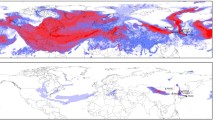Abstract
Based on the fact that such events as an explosion of the Tunguska cosmic body, which caused the fall of trees in a wide area and the release of radiant energy during the Tunguska disaster, proved to be separated not only in space but also in time, it is concluded that these events are interrelated but different. The assumption is justified that the emission during the Tunguska disaster was caused by the atmospheric discharge at altitudes of 10–90 km above the Earth’s surface. The emission energy, released during this discharge, could reach ∼1010 J.
Similar content being viewed by others
References
I. S. Astapovich, “Great Tunguska Meteorite: Results of Studies,” Priroda, No. 3, 13–23 (1951).
V. A. Bronshten, “Electric and Electromagnetic Phenomena Accompanying Flight of Meteors,” Astron. Vestn. 25(2), 490–504 (1991).
W. D. Crozier, “Dust Devil Properties,” J. Geophys. Res. 75(24), 4583–4585 (1970).
H. F. Eden and B. Vonnegut, “Electrical Breakdown Caused by Dust Motion in Low-Pressure Atmosphere: Considerations for Mars,” Science 180(4089), 962–963 (1973).
V. G. Fast, A. P. Brannik, and S. A. Razin, “On the Role of Felled Wood Directions in the Region of the Tunguska Meteorite Fall,” in Problems of Meteoritics, Ed. by N. V. Vasil’eva (TGU, Tomsk, 1976), pp. 39–51 [in Russian].
V. G. Fesenko, “Atmospheric Turbidity Caused by the Tunguska Meteorite Fall on June 30, 1908,” Meteoritika, No. 6, 8–12 (1949).
K. P. Florensky, B. I. Vronskii, Yu. M. Emel’yanov, I. T. Zotkin, and O. A. Kirova, “Preliminary Results of the Tunguska Meteoritic Expedition of 1958,” Meteoritika, No. 19, 103–134 (1960).
O. G. Gladysheva, “To the Problem of the Tunguska Meteorite Substance,” Astron. Vestn. 41(4), 345–352 (2007).
O. G. Gladysheva, Preprint No. 1787.31, FTI (2005).
O. G. Gladysheva, “Comet Structure of the Tunguska Body,” in Proceedings of the Jubilee Conference of the Russian Geographic Society “100-Year Anniversary of the Tunguska Comet Body”, Ed. by K. K. Khazanovich-Vul’f (St. Petersburg, 2008), pp. 29–32 [in Russian].
S. P. Golenetskii and V. V. Stepanok, “Certain Features of the Local Structure of the Tunguska Disaster that Occurred in 1908,” in Meteoritic Studies in Siberia, Ed. by Yu. A. Dolgov (Nauka SO, Novosibirsk, 1984) [in Russian].
R. C. Harrison and K. S. Carslaw, “Ion-Aerosol-Cloud Processes in the Lower Atmosphere,” Rev. Geophys. 41(3), 1012–1037 (2003).
A. K. Kamra, “Measurements of the Electrical Properties of Dust Storms,” J. Geophys. Res. 77(30), 5856–5869 (1972).
O. A. Kirova, “On Mineralogical Studies of Soil Samples from the Tunguska Meteorite Fall Region, Taken by the Expedition in 1958,” Meteoritika, No. 20, 32–39 (1961).
V. G. Konenkin, “Reports of Eyewitnesses to the Tunguska Meteorite of 1908,” Probl. Tungus. Meteor., No. 2, 31–35 (1967).
E. L. Krinov, Tunguska Meteorite (Akad. Nauk SSSR, Moscow, 1949) [in Russian].
E. L. Krinov, Messengers of the Universe (GIGL, Moscow, 1963) [in Russian].
L. A. Kulik, “Data on the Tunguska Meteorite by 1939,” Dokl. Akad. Nauk SSSR 22(8), 520–524 (1939).
L. A. Kulik, “To the History of a Bolide of June 30, 1908,” Dokl. Akad. Nauk SSSR, Ser. A, No. 23, 393–394 (1927).
G. Longo, R. Serra, S. Cecchini, and M. Galli, “Search for Microremnants of the Tunguska Cosmic Body,” Planet. Space Sci. 42(2), 163–177 (1994).
V. V. Muchnik, Thunderstorm Physics (Gidrometeoizdat, Leningrad, 1974) [in Russian].
R. Roussel-Dupre and A. V. Gurevich, “On Runaway Breakdown and Upward Propagating Discharges,” J. Geophys. Res. 101A, 2297–2311 (1996).
D. D. Sentman, E. N. Wescott, D. L. Osborne, et al., “Preliminary Results from the Sprites95 Campaign: 1. Red Sprites,” Geophys. Res. Lett. 22(10), 1205–1208 (1995).
A. A. Sickafoose, J. E. Colwell, M. Horanyi, and S. Robertson, “Experimental Investigations on Photoelectric and Triboelectric Charging of Dust,” J. Geophys. Res. 106A, 8343–8456 (2001).
I. M. Suslov, “Examination of Eyewitnesses to the Tunguska Disaster of 1926,” Probl. Tungus. Meteor., No. 2, 21–30 (1967).
N. V. Vasil’ev, “State of the Tunguska Meteorite Problem at the Beginning of 1974,” in Problems of Meteoritics, Ed. by V. S. Sobolev (Nauka, Novosibirsk, 1975), pp. 3–12 [in Russian].
V. A. Vorob’ev and D. V. Demin, “New Results of Studying Thermal Affection of Larches in the Tunguska Meteorite Fall Region,” Problems of Meteoritics, Ed. by N. V. Vasil’ev (TGU, Tomsk, 1976), pp. 58–63 [in Russian].
A. V. Voznesenskii, “Meteorite Fall of June 30, 1908, in the Khatanga River Upper Reaches,” Mirovedenie 14(1), 25–38 (1925).
F. J. W. Whipple, “The Great Siberian Meteor and the Waves, Seismic and Aerial, Which It Produced,” Quart. J. R. Meteorol. Soc. 56(236), 287–301 (1930).
C. T. R. Wilson, “A Theory of Thundercloud Electricity,” Proc. R. Soc. Ser. A 236, 297–317 (1956).
G. M. Zenkin and A. G. Il’in, “On a Radiation Burn of Trees in the Tunguska Meteorite Explosion Region,” Meteoritika, No. 24, 129–140 (1964).
G. M. Zenkin, A. G. Il’in, A. I. Egorshin, A. P. Boyarkina, S. E. Ven’yaminov, and L. F. Shikalov, “Characterization of Trees that Survived in the Epicenter of the Tunguska Disaster,” in The Problem of the Tunguska Meteorite, Ed. by G. F. Plekhanov (TGU, Tomsk, 1963), pp. 84–63 [in Russian].
A. V. Zolotov, “Estimation of the Tunguska Cosmic Body Parameters Using New Data,” Dokl. Akad. Nauk SSSR 172(5), 1049–1052 (1967).
Author information
Authors and Affiliations
Corresponding author
Additional information
Original Russian Text © O.G. Gladysheva, 2009, published in Geomagnetizm i Aeronomiya, 2009, Vol. 49, No. 3, pp. 416–423.
Rights and permissions
About this article
Cite this article
Gladysheva, O.G. Atmospheric discharge as a source of emission during the Tunguska disaster. Geomagn. Aeron. 49, 397–404 (2009). https://doi.org/10.1134/S0016793209030141
Received:
Accepted:
Published:
Issue Date:
DOI: https://doi.org/10.1134/S0016793209030141




